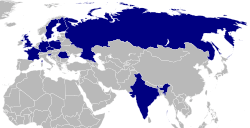Facility for Antiproton and Ion Research
The Facility for Antiproton and Ion Research (FAIR)[1] is an international accelerator facility under construction which will use antiprotons and ions to perform research in the fields of: nuclear, hadron and particle physics, atomic and anti-matter physics, high density plasma physics, and applications in condensed matter physics, biology and the bio-medical sciences. It is situated in Darmstadt in Germany.
 | |
 | |
| Abbreviation | FAIR |
|---|---|
| Formation | 2010 |
| Location | |
Scientific Managing Director | Paolo Giubellino |
Administrative Managing Director | Dr. Ulrich Breuer |
Technical Managing Director | Jörg Blaurock |
| Website | fair-center.eu |
FAIR will be based upon an expansion of the GSI Helmholtz Centre for Heavy Ion Research, the details of which have been laid out in the FAIR Baseline Technical Report 2006.[2] On October 4, 2010 the Facility for Antiproton and Ion Research in Europe limited liability company (German GmbH), abbreviated as FAIR GmbH, was founded which coordinates the construction of the new accelerators and experiments.
The construction begun at summer of 2017.[3] Commissioning is planned for 2025. The original budget had been estimated at 1262 million euro (2005 price level),[4] in 2018 the German Federal Court of Auditors stated that the cost of FAIR had increased to at least 1669 million euro (2005 prices),[5] in 2019 a further report by the Federal Court of Auditors quoted results from a review board that an additional 850 million euro (2019 prices) would be needed to finish building the facility.[6]
FAIR science case
The four scientific pillars of FAIR are:
- Atomic, Plasma Physics and Applications - APPA,[7]
- Compressed Baryonic Matter - CBM,[8]
- Nuclear Structure, Astrophysics and Reactions - NUSTAR,[9]
- antiProton ANnihilation at DArmstadt - PANDA.[10]
Those are described on the web pages of FAIR (see [11] and links therein).
FAIR accelerators

Beams of protons will be prepared in the proton linear accelerator, p-LINAC, while heavy ions will be prepared in the UNILAC. Both of them will be fed into the SIS18. From there they will be directed into SIS100 (and SIS300 if applicable). Protons will be used either to produce antiproton beams by directing them on a dedicated production target or directly used for experiments within APPA. These antiprotons will be captured and cooled in the Collector Ring, CR (and RESR when available) before being injected into HESR, where they will be utilised within the PANDA experiment. High energetic heavy ions will either be used directly for studies with the CBM or APPA experiments or to produce unstable ion beams. The latter will be produced in the Rare Isotope Production Target and filtered the Super-FRS, where the NUSTAR experiments will take place.
FAIR partner
Countries
Roughly 3,000 scientists from more than 50 countries are already working on the planning of the experiment and accelerator facilities. This project is realised by partners from Finland, France, Germany, India, Poland, Romania, Russia, Slovenia and Sweden that have signed an international treaty, the FAIR Convention, which formally entered into force in March 2014. The UK has joined 2013 as first associate member.[12] 2018 joined the Czech Republic as aspirant partner. Further countries, like Italy, are in negotiations.
![]()
![]()
![]()
![]()
![]()
![]()
![]()
![]()
![]()
![]()
![]()
Institutions
FAIR has also formed a strategic partnership with the Technische Universität Darmstadt, which is located in the same town as FAIR.[13][14]
Notes
- "FAIR home page". Retrieved 12 February 2013.
- FAIR - Baseline Technical Report. 2006. ISBN 3-9811298-0-6. Archived from the original on 2014-03-26. Retrieved 2013-02-12.
- "The FAIR mega-construction project". GSI. October 24, 2018.
- "Facts and figures". GSI. December 2, 2015.
- "2018 Bericht - Bau des Beschleunigerkomplexes „FAIR" in Darmstadt - Aktueller Stand und Risiken des FAIR-Projekts nach Baubeginn — Startseite". www.bundesrechnungshof.de.
- https://www.bundesrechnungshof.de/de/veroeffentlichungen/produkte/beratungsberichte/entwicklung-einzelplaene/2020/langfassungen/2019-bericht-information-ueber-die-entwicklung-des-einzelplans-30-bundesministerium-fuer-bildung-und-forschung-fuer-die-beratungen-zum-bundeshaushalt-2020-pdf
- "APPA summary". Retrieved 12 February 2013.
- CBM Collaboration. "CBM home page". Retrieved 12 February 2013.
- NUSTAR Collaboration. "NUSTAR home page". Retrieved 12 February 2013.
- PANDA Collaboration. "PANDA home page". Retrieved 12 February 2013.
- "Planned experiments at FAIR". FAIR. Retrieved 12 Feb 2013.
- "Britain signs up to world's hottest nuclear physics project". Guardian. 3 May 2013. Retrieved 13 May 2013.
- GmbH, Echo Zeitungen. "GSI und TU Darmstadt setzen ihre wissenschaftliche Partnerschaft fort - Echo Online". www.echo-online.de (in German). Retrieved 2019-07-30.
- Pietralla, Arbeitsgruppe. "FAIR". Arbeitsgruppe Pietralla – Technische Universität Darmstadt (in German). Retrieved 2019-07-30.